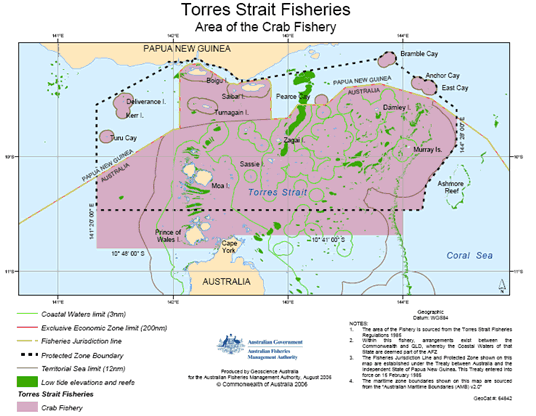About the Torres Strait Crab Fishery
The Torres Strait Crab Fishery primarily targets mud crab (Scylla spp.) although a small quantity of blue simmer crab (Portunus pelagicus) is occasionally taken. Mud crabs are generally captured by hand or using scoop nets. The level of participation in the commercial fishery is low due to other fisheries being relatively more profitable.
Fishery Map

Map showing the area of the Torres Strait Crab Fishery (2006)
The objectives for the Torres Strait Crab Fishery have been developed in conjunction with the objectives of the Torres Strait Fisheries Act 1984 and the Torres Strait Treaty to reflect the new status of the fishery following the change in jurisdiction from a fishery managed solely under Queensland law. These are to:
- to manage the resource so as to achieve optimum utilisation; and
- to maximise opportunities for Traditional Inhabitants of Australia and PNG to participate in the commercial fishery.
In the Crab Fishery, participation is limited to Traditional Inhabitants so as to maximise their opportunities. Regulations currently implemented in the Crab Fishery in Fisheries Management Notice (FMN) 50 include:
- a prohibition on the take or possession of female crabs;
- no vessels greater than 14 m in length;
- restricting the number of prescribed crab apparatus to less than 50;
- prohibition on the take or possession of spanner crab (Ranina ranina); and
- a minimum carapace length of 15 cm.
Note: Where the carapace is missing the underside of the body on one side from the notch at the junction of the claw with the body to the notch at the junction of the last leg with the body must be greater than 37 mm in length for blue swimmer crabs and 46mm for mud crabs.
The status of crab stocks in the TSPZ is uncertain at present. Anecdotal information suggests most fishing effort appears to be around the north-western section of the TSPZ, namely Saibai Island, Boigu Island and Dauan Island, as well as further south around the Cape York Peninsula. There are 78 Traditional Inhabitant vessels presently authorised to operate in the Crab Fishery in 2010. Fishery participants are therefore comprised of Australian Traditional Inhabitants only. An unknown but relatively small quantity of mud crabs are taken in the course of traditional fishing.